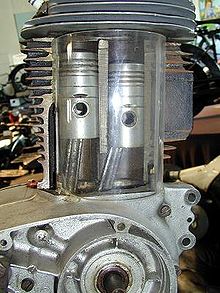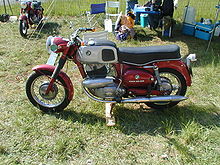Puch two-stroke twin piston engine
The Puch two-stroke twin-piston engine was a DC-flushed two-stroke engine in which two pistons in cylinders directly adjacent to one another share the combustion chamber and act on a crankshaft throat via a split connecting rod. Because of its technical characteristics and its modest fuel consumption , it was used in motorcycles . The Puch works in Graz produced engines of this type from 1923 to 1970.
Other important manufacturers of double piston engines were Garelli in Italy and the Triumph works in Nuremberg .
history
The Italian engineer Giovanni Marcellino invented and designed this engine for Puch in the 1920s . He tried to save the Graz company from a financial crisis by installing it in a “people's motorcycle”. This succeeded very quickly: the double-piston engine became a great success. For decades, Puch primarily equipped his motorcycles with a displacement of 125 to 500 cubic centimeters with him. Until 1970, Puch 250 SG (A), 250 SGS , 250 TF , 175 SV etc. machines with two-stroke double-piston engines rolled off the production line in Graz .
principle
In the two-stroke engine based on the Puch double piston principle, each crankshaft offset acts on a combustion chamber via a forked or split connecting rod and two pistons in their own cylinders. The two pistons do not run parallel, that is, one piston rushes ahead during compression and lags behind during the work cycle. This allows the opening and closing of the slots in the cylinder walls for the inlet and outlet to be easily controlled (asymmetrical control diagram ). The purging in the cylinder was better than with other two-stroke engines, almost no fresh gas was emitted. The result was lower fuel consumption . The engines were originally installed lengthways in motorcycles, the double cylinder was evenly cooled by the airstream. With the Puch 500 , two units were installed lengthways one behind the other and the rear cylinders were less well cooled, which limited the performance. After the Second World War, single-cylinder engines were also installed transversely, which resulted in cooling problems for the rear part. The engines ran for several thousand hours without repair and remained economical; a disadvantage was the risk of piston jamming if the fuel ran out.
literature
- Friedrich F. Ehn: The great Puch book. Puch two-wheeler production from 1890–1987. 8th edition. Weishaupt, Gnas 2013, ISBN 978-3-900310-49-3 .

